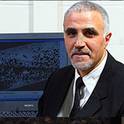Carbon-based materials are considered to be promising as implants because of their unique mechanical and biocompatibility properties. This article investigates the use of carbon-based materials as a functional interface for tissue scaffolds and medical implants. Three basic parameters were explored: graphene orientation, crystallinity, and surface interaction. These parameters were measured using optical microscopy, x-ray diffraction, and atomic force microscopy. To explore the effect of the orientation, samples were made with and without a preferred carbon orientation. Conversely, the crystallinity was studied using graphitic and carbonaceous matrices. Finally, the surface interaction study was carried out using oxygen surface functionalized and non-functionalized carbon fibers. Fluorescent, confocal, and environmental scanning microscopy were used to visualize cell response. The cell attachment, proliferation, and elongation were prevalent on the unidirectional carbon preform. Cells tended to orient parallel to the fiber axis (parallel to the 002 graphene plane) and proliferate as a function of higher crystallinity, although the addition of oxygen or other functional groups disrupted the interaction between cells and graphene surface and inhibited the growth. In conclusion, osteoblast (bone-forming cells) attachment and overall growth is a function of crystallite size, graphene orientation, and carbon graphitization.
Available at: http://works.bepress.com/khalid_lafdi/91/
